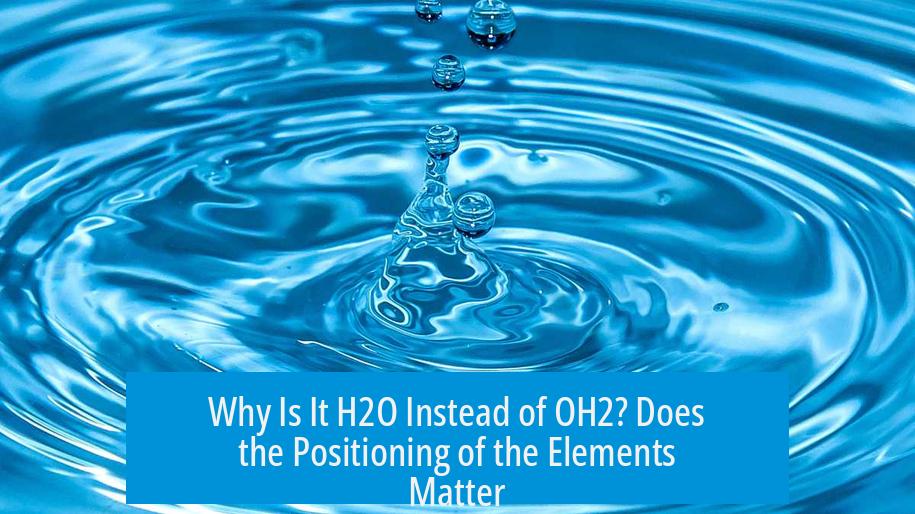Why Is It H2O Instead of OH2? Does the Positioning of the Elements Matter?

The chemical formula for water is conventionally written as H2O rather than OH2 because standard naming conventions place hydrogen before oxygen, following rules based on electronegativity, ionic character, and clarity. While reversing the order does not affect the actual chemical composition, writing it as OH2 may cause confusion because OH represents a distinct hydroxide group.
This article explores why H2O is the accepted formula for water, the principles guiding element positioning in chemical formulas, and exceptions where order matters for clarity and chemical identity.
Naming and Writing Conventions for Chemical Formulas
General Conventions in Chemical Formula Writing

Chemical formulas generally follow conventions to improve readability and convey information effectively. While the order of elements in chemical formulas does not change the substance’s identity, standardized formats aid in communication.
In molecular or structural depictions, formulas can be adapted to fit diagrams. Sometimes, alternate representations like hydrogen hydroxide (H–OH) emphasize bonding and structure rather than mere element count. For example, “OH2” is theoretically valid but uncommon and potentially confusing.
Placement of Acidic Hydrogens
In inorganic chemistry, acidic hydrogens are typically written at the beginning of formulas. Examples include nitric acid (HNO3) and sulfuric acid (H2SO4). This rule highlights the acidic proton, crucial in defining the molecule’s chemical behavior.
Water’s hydrogens are acidic in a weak sense, leading to the convention of listing hydrogens first. This approach supports recognizing H2O as a molecule capable of donating protons under specific scenarios.
Cation-Anion and Electronegativity-based Ordering
Formulas of ionic compounds place cations before anions. For instance, sodium chloride is NaCl, with Na+ as the cation and Cl– as the anion. Although water is covalent, similar principles influence its formula.
For covalent compounds, the less electronegative element precedes the more electronegative. Since hydrogen has an electronegativity (~2.2) lower than oxygen (~3.44), hydrogen is written first: H2O rather than OH2.
Alphabetical Order in Organic Compounds
Organic compound formulas often follow specific sequencing for clarity. Carbons are listed first, followed by hydrogens, and then other atoms alphabetically. For example, glucose is C6H12O6. This convention emphasizes the carbon backbone’s prominence in organic molecules.
Specific Explanation on H2O vs OH2
Does the Positioning Matter Theoretically?
From a purely theoretical standpoint, switching the order of atoms in a molecular formula does not change the molecule’s identity. H2O and OH2 represent the same number of atoms bonded identically.
However, conventions matter to sustain uniformity in chemical communication. H2O is universally recognized as water due to established standards.
Why Is H2O Preferred Practically?
OH is a chemically distinct group known as the hydroxide radical or group. Writing water as OH2 may cause confusion, implying it is a hydroxide entity attached to an additional hydrogen atom, which differs in properties.
Therefore, using H2O makes it clear the molecule is simple water, not a compound involving hydroxide anion or radical plus hydrogen.
Structural Flexibility in Formulas and Diagrams
In organic chemistry or molecular diagrams, the atom order may be altered to emphasize bonding or structure. Notation flexibility helps show connectivity but does not alter chemical identity.
For water, however, since the molecule is simple and well-known, the common formula H2O prevails.
Avoiding Unnecessary Confusion
Choosing a formula representation that reduces misunderstanding is essential. For water, H2O accomplishes this effectively. Writing OH2 is rare and risks causing confusion, particularly among students and practitioners.
Illustrative Examples Highlighting the Importance of Positioning
Cyanates vs Isocyanates
In some compounds, element positioning in formulas profoundly affects chemical identity. Cyanates, written as -OCN, differ chemically and functionally from isocyanates, written as -NCO.
Despite having the same elemental composition, the distinct arrangement results in different chemical properties. This example underscores why positioning matters more in some molecules than others.
Summary Table: Conventions Influencing Element Positioning
| Convention Type | Description | Example |
|---|---|---|
| Acidic Hydrogen First | Write acidic hydrogens before other elements in inorganic acids. | HNO3, H2SO4, H2O |
| Cation-Anion Order | Cations appear before anions in ionic compounds. | NaCl, K2SO4 |
| Electronegativity Order | Elements written from less electronegative to more electronegative. | H2O, CO2 |
| Alphabetical Order (Organic) | For organic compounds, atoms averaged by C, H, then alphabetical order. | C6H12O6 (glucose) |
Key Takeaways
- H2O is written with hydrogen before oxygen due to well-established chemical conventions.
- Hydrogen is less electronegative than oxygen, so it is placed first in the formula.
- Writing OH2 might cause confusion as OH denotes a separate hydroxide group.
- Element positioning is important in some molecules where arrangement affects chemical properties, such as cyanates vs isocyanates.
- General guidelines for formula order include acidic hydrogens first, cation-anion sequence, electronegativity order, or alphabetical order depending on the compound class.
Why is water written as H2O instead of OH2?
Water is written as H2O by convention. The hydrogen atoms come first because they are electropositive, followed by the more electronegative oxygen. Writing OH2 could confuse it with the hydroxide ion (OH).
Does the order of elements in a chemical formula affect the molecule’s identity?
Usually, the order does not change the molecule’s identity. However, in some cases like cyanates (OCN) and isocyanates (NCO), different orders indicate different compounds with distinct properties.
Are there specific rules for choosing the order of elements in chemical formulas?
Yes. Orders often follow electronegativity, cation-anion relationships, acidic hydrogen placement, or alphabetical order depending on the compound class. For example, acidic hydrogens are written first in inorganic acids.
Can chemical formulas be written differently in diagrams or structures?
Yes. The order of elements can be rearranged in diagrams to clarify atomic connections or fit the structure better. For example, organic chemistry structures may place elements for visual clarity rather than strict formula order.
Why avoid writing water as OH2 if it is theoretically the same?
Writing OH2 is avoided to prevent confusion with the hydroxide ion (OH). Even if the molecule remains the same chemically, using H2O conforms to widely accepted naming that ensures clear communication.





Leave a Comment